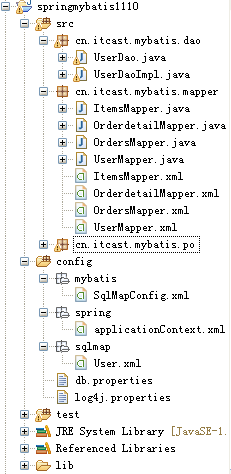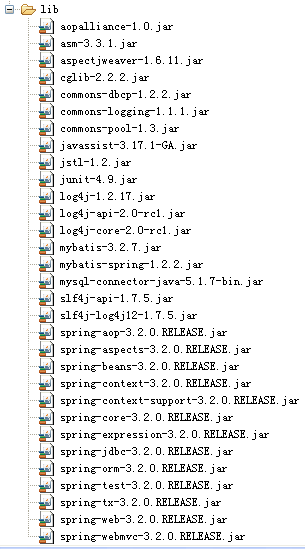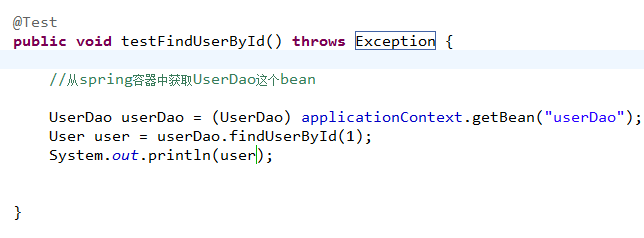mybatis0211 mybatis和spring整合
1mybatis和spring整合
1.1 mybaits和spring整合的思路
、让spring管理SqlSessionFactory
、让spring管理mapper动态代理对象和dao。
使用spring和mybatis整合开发mapper代理及原始dao接口。
自动开启事务,自动关闭 sqlsession.
、让spring管理数据源( 数据库连接池)
.2创建整合工程


.1加入jar包
、mybatis3..7本身的jar包
、数据库驱动包
、spring3.2.0
、spring和mybatis整合包
从mybatis的官方下载spring和mybatis整合包

.1log4j.properties
.2SqlMapconfig.xml
mybatis配置文件:别名、settings,数据源不在这里配置
<!DOCTYPE configuration
PUBLIC "-//mybatis.org//DTD Config 3.0//EN"
"http://mybatis.org/dtd/mybatis-3-config.dtd">
<configuration>
<!-- 定义 别名 -->
<typeAliases>
<!-- 批量别名定义 指定包路径,自动扫描包下边的pojo,定义别名,别名默认为类名(首字母小写或大写) -->
<package name="cn.itcast.mybatis.po" />
</typeAliases>
<mappers>
<!-- 加载原始dao使用的user.xml -->
<mapper resource="sqlmap/User.xml"/>
<package name="cn.itcast.mybatis.mapper" />
</mappers>
</configuration>
1.3 applicationContext.xml
、数据源(dbcp连接池)
、SqlSessionFactory
、mapper对象(bin)或dao
.4整合开发原始dao接口
1.4.1配置SqlSessionFactory
在 applicationContext.xml配置SqlSessionFactory
<!-- SqlsessionFactory -->
<bean id="sqlSessionFactory" class="org.mybatis.spring.SqlSessionFactoryBean">
<!-- 数据源 -->
<property name="dataSource" ref="dataSource"/>
<!-- mybatis配置文件 -->
<property name="configLocation" value="classpath:mybatis/SqlMapConfig.xml"/>
</bean> <!-- 加载配置文件 -->
<context:property-placeholder location="classpath:db.properties" />
<!-- 数据库连接池 -->
<bean id="dataSource" class="org.apache.commons.dbcp.BasicDataSource"
destroy-method="close">
<property name="driverClassName" value="${jdbc.driver}" />
<property name="url" value="${jdbc.url}" />
<property name="username" value="${jdbc.username}" />
<property name="password" value="${jdbc.password}" />
<property name="maxActive" value="" />
<property name="maxIdle" value="" />
</bean> db.properties:
jdbc.driver=com.mysql.jdbc.Driver
jdbc.url=jdbc:mysql://localhost:3306/mybatis
jdbc.username=root
jdbc.password=mysql 1.4.2开发dao
public class UserDaoImpl extends SqlSessionDaoSupport implements UserDao {
@Override
public User findUserById(int id) throws Exception {
// 创建SqlSession
SqlSession sqlSession = this.getSqlSession();//getSqlSession从SqlSessionDaoSupport 获取
// 根据id查询用户信息
User user = sqlSession.selectOne("test.findUserById", id);
return user;
}
}
1.4.3applicationContext.xml配置 dao
<!-- 配置dao -->
<bean id="userDao" class="cn.itcast.mybatis.dao.UserDaoImpl">
<property name="sqlSessionFactory" ref="sqlSessionFactory"/>
</bean>
1.4.4测试dao接口

.1整合开发mapper代理方法
(mapper开发只写接口不写实现类,实现类由mybatis动态生成),
1.1.1开发mapper.xml和mapper.java

1.1.1applicationContext.xml使用MapperFactoryBean
<!-- 配置mapper
MapperFactoryBean:用于生成mapper代理对象,当有多个mapper的时候每一个mapper都要配置,
-->
<bean id="userMapper" class="org.mybatis.spring.mapper.MapperFactoryBean">
<property name="mapperInterface" value="cn.itcast.mybatis.mapper.UserMapper"/>全路径名
<property name="sqlSessionFactory" ref="sqlSessionFactory"/>没有整合spring的时候是通过sqlSessionFactory得到sqlSession再通过getMapper()方法,
</bean>
使用此方法对于每个mapper都需要配置,比较繁琐。
1.1.2applicationContext.xml使用MapperScannerConfigurer(扫描mapper)
<!--
MapperScannerConfigurer:mapper的扫描器,将包下边的mapper接口自动创建代理对象,
自动创建到spring容器中,bean的id是mapper的类名(首字母小写)
-->
<bean class="org.mybatis.spring.mapper.MapperScannerConfigurer">
<!-- 配置扫描包的路径
如果要扫描多个包,中间使用半角逗号分隔
-->
<property name="basePackage" value="cn.itcast.mybatis.mapper"/>
<!-- 使用sqlSessionFactoryBeanName -->
<property name="sqlSessionFactoryBeanName" value="sqlSessionFactory"/>
</bean>
使用扫描器自动扫描mapper,生成代理对象,比较方便。
1.1.3测试mapper接口

全部代码:
UserMapper
public interface UserMapper {
//根据用户id查询用户信息
public User findUserById(int id) throws Exception;
//根据用户名称 查询用户信息
public List<User> findUserByName(String username) throws Exception;
//自定义查询条件查询用户信息
public List<User> findUserList(UserQueryVo userQueryVo) throws Exception;
//查询用户,使用resultMap进行映射
public List<User> findUserListResultMap(UserQueryVo userQueryVo)throws Exception;
//查询用户,返回记录个数
public int findUserCount(UserQueryVo userQueryVo) throws Exception;
//插入用户
public void insertUser(User user)throws Exception;
//删除用户
public void deleteUser(int id) throws Exception;
//修改用户
public void updateUser(User user) throws Exception;
}
UserMapper.xml
<?xml version="1.0" encoding="UTF-8" ?>
<!DOCTYPE mapper
PUBLIC "-//mybatis.org//DTD Mapper 3.0//EN"
"http://mybatis.org/dtd/mybatis-3-mapper.dtd">
<!-- namespace命名空间,为了对sql语句进行隔离,方便管理 ,mapper开发dao方式,使用namespace有特殊作用
mapper代理开发时将namespace指定为mapper接口的全限定名
-->
<mapper namespace="cn.itcast.mybatis.mapper.UserMapper">
<!-- 在mapper.xml文件中配置很多的sql语句,执行每个sql语句时,封装为MappedStatement对象
mapper.xml以statement为单位管理sql语句
--> <!-- 将用户查询条件定义为sql片段
建议对单表的查询条件单独抽取sql片段,提高公用性
注意:不要将where标签放在sql片段
-->
<sql id="query_user_where">
<!-- 如果 userQueryVo中传入查询条件,再进行sql拼接-->
<!-- test中userCustom.username表示从userQueryVo读取属性值-->
<if test="userCustom!=null">
<if test="userCustom.username!=null and userCustom.username!=''">
and username like '%${userCustom.username}%'
</if>
<if test="userCustom.sex!=null and userCustom.sex!=''">
and sex = #{userCustom.sex}
</if> <!-- 还有很的查询条件 -->
</if>
<if test="ids!=null">
<!-- 根据id集合查询用户信息 -->
<!-- 最终拼接的效果:
SELECT id ,username ,birthday FROM USER WHERE username LIKE '%小明%' AND id IN (,,)
collection:集合的属性
open:开始循环拼接的串
close:结束循环拼接的串
item:每次循环取到的对象
separator:每两次循环中间拼接的串
-->
<foreach collection="ids" open=" AND id IN ( " close=")" item="id" separator=",">
#{id}
</foreach>
<!--
SELECT id ,username ,birthday FROM USER WHERE username LIKE '%小明%' AND (id = OR id = OR id = )
<foreach collection="ids" open=" AND ( " close=")" item="id" separator="OR">
id = #{id}
</foreach>
-->
</if>
</sql> <!-- 定义resultMap,列名和属性名映射配置
id:mapper.xml中的唯一标识
type:最终要映射的pojo类型
-->
<resultMap id="userListResultMap" type="user" >
<!-- 列名
id_,username_,birthday_
id:要映射结果集的唯 一标识 ,称为主键
column:结果集的列名
property:type指定的哪个属性中
-->
<id column="id_" property="id"/>
<!-- result就是普通列的映射配置 -->
<result column="username_" property="username"/>
<result column="birthday_" property="birthday"/> </resultMap> <!-- 根据id查询用户信息 -->
<!--
id:唯一标识 一个statement
#{}:表示 一个占位符,如果#{}中传入简单类型的参数,#{}中的名称随意
parameterType:输入 参数的类型,通过#{}接收parameterType输入 的参数
resultType:输出结果 类型,不管返回是多条还是单条,指定单条记录映射的pojo类型
-->
<select id="findUserById" parameterType="int" resultType="user" >
SELECT * FROM USER WHERE id= #{id} </select> <!-- 根据用户名称查询用户信息,可能返回多条
${}:表示sql的拼接,通过${}接收参数,将参数的内容不加任何修饰拼接在sql中。 -->
<select id="findUserByName" parameterType="java.lang.String" resultType="cn.itcast.mybatis.po.User">
select * from user where username like '%${value}%'
</select> <!-- 自定义查询条件查询用户的信息
parameterType:指定包装类型
%${userCustom.username}%:userCustom是userQueryVo中的属性,通过OGNL获取属性的值
-->
<select id="findUserList" parameterType="userQueryVo" resultType="user"> select id,username,birthday from user
<!-- where标签相当 于where关键字,可以自动去除第一个and -->
<where>
<!-- 引用sql片段,如果sql片段和引用处不在同一个mapper必须前边加namespace -->
<include refid="query_user_where"></include>
<!-- 下边还有很其它的条件 -->
<!-- <include refid="其它的sql片段"></include> -->
</where> </select> <!-- 使用resultMap作结果映射
resultMap:如果引用resultMap的位置和resultMap的定义在同一个mapper.xml,
直接使用resultMap的id,如果不在同一个mapper.xml要在resultMap的id前边加namespace -->
<select id="findUserListResultMap" parameterType="userQueryVo" resultMap="userListResultMap"> select id id_,username username_,birthday birthday_ from user where username like '%${userCustom.username}%'
</select> <!-- 输出简单类型
功能:自定义查询条件,返回查询记录个数,通常用于实现 查询分页
-->
<select id="findUserCount" parameterType="userQueryVo" resultType="int">
select count(*) from user
<!-- where标签相当 于where关键字,可以自动去除第一个and -->
<where>
<!-- 引用sql片段,如果sql片段和引用处不在同一个mapper必须前边加namespace -->
<include refid="query_user_where"></include>
<!-- 下边还有很其它的条件 -->
<!-- <include refid="其它的sql片段"></include> -->
</where>
</select> <!-- 添加用户
parameterType:输入 参数的类型,User对象 包括 username,birthday,sex,address
#{}接收pojo数据,可以使用OGNL解析出pojo的属性值
#{username}表示从parameterType中获取pojo的属性值
selectKey:用于进行主键返回,定义了获取主键值的sql
order:设置selectKey中sql执行的顺序,相对于insert语句来说
keyProperty:将主键值设置到哪个属性
resultType:select LAST_INSERT_ID()的结果 类型 -->
<insert id="insertUser" parameterType="cn.itcast.mybatis.po.User" >
<selectKey keyProperty="id" order="AFTER" resultType="int">
select LAST_INSERT_ID()
</selectKey> INSERT INTO USER(username,birthday,sex,address) VALUES(#{username},#{birthday},#{sex},#{address})
</insert> <!-- mysql的uuid生成主键 -->
<!-- <insert id="insertUser" parameterType="cn.itcast.mybatis.po.User">
<selectKey keyProperty="id" order="BEFORE" resultType="string">
select uuid()
</selectKey> INSERT INTO USER(id,username,birthday,sex,address) VALUES(#{id},#{username},#{birthday},#{sex},#{address})
</insert> --> <!-- oracle
在执行insert之前执行select 序列.nextval() from dual取出序列最大值,将值设置到user对象 的id属性
-->
<!-- <insert id="insertUser" parameterType="cn.itcast.mybatis.po.User">
<selectKey keyProperty="id" order="BEFORE" resultType="int">
select 序列.nextval() from dual
</selectKey> INSERT INTO USER(id,username,birthday,sex,address) VALUES(#{id},#{username},#{birthday},#{sex},#{address})
</insert> --> <!-- 用户删除 -->
<delete id="deleteUser" parameterType="int">
delete from user where id=#{id}
</delete>
<!-- 用户更新
要求:传入的user对象中包括 id属性值
-->
<update id="updateUser" parameterType="cn.itcast.mybatis.po.User" flushCache="false">
update user set username=#{username},birthday=#{birthday},sex=#{sex},address=#{address} where id=#{id}
</update> </mapper>
SqlMapConfig.xml
<!DOCTYPE configuration
PUBLIC "-//mybatis.org//DTD Config 3.0//EN"
"http://mybatis.org/dtd/mybatis-3-config.dtd">
<configuration>
<!-- 定义 别名 -->
<typeAliases>
<!-- 批量别名定义 指定包路径,自动扫描包下边的pojo,定义别名,别名默认为类名(首字母小写或大写) -->
<package name="cn.itcast.mybatis.po" />
</typeAliases>
<mappers>
<!-- 加载原始dao使用的user.xml -->
<mapper resource="sqlmap/User.xml"/>
<package name="cn.itcast.mybatis.mapper" />
</mappers>
</configuration>
applicationContext.xml
<beans xmlns="http://www.springframework.org/schema/beans"
xmlns:xsi="http://www.w3.org/2001/XMLSchema-instance" xmlns:mvc="http://www.springframework.org/schema/mvc"
xmlns:context="http://www.springframework.org/schema/context"
xmlns:aop="http://www.springframework.org/schema/aop" xmlns:tx="http://www.springframework.org/schema/tx"
xsi:schemaLocation="http://www.springframework.org/schema/beans
http://www.springframework.org/schema/beans/spring-beans-3.2.xsd
http://www.springframework.org/schema/mvc
http://www.springframework.org/schema/mvc/spring-mvc-3.2.xsd
http://www.springframework.org/schema/context
http://www.springframework.org/schema/context/spring-context-3.2.xsd
http://www.springframework.org/schema/aop
http://www.springframework.org/schema/aop/spring-aop-3.2.xsd
http://www.springframework.org/schema/tx
http://www.springframework.org/schema/tx/spring-tx-3.2.xsd "> <!-- 加载配置文件 -->
<context:property-placeholder location="classpath:db.properties" />
<!-- 数据库连接池 -->
<bean id="dataSource" class="org.apache.commons.dbcp.BasicDataSource"
destroy-method="close">
<property name="driverClassName" value="${jdbc.driver}" />
<property name="url" value="${jdbc.url}" />
<property name="username" value="${jdbc.username}" />
<property name="password" value="${jdbc.password}" />
<property name="maxActive" value="" />
<property name="maxIdle" value="" />
</bean> <!-- SqlsessionFactory -->
<bean id="sqlSessionFactory" class="org.mybatis.spring.SqlSessionFactoryBean">
<!-- 数据源 -->
<property name="dataSource" ref="dataSource"/>
<!-- mybatis配置文件 -->
<property name="configLocation" value="classpath:mybatis/SqlMapConfig.xml"/>
</bean> <!-- 配置dao -->
<bean id="userDao" class="cn.itcast.mybatis.dao.UserDaoImpl">
<property name="sqlSessionFactory" ref="sqlSessionFactory"/>
</bean> <!-- 配置mapper
MapperFactoryBean:用于生成mapper代理对象,当有多个mapper的时候每一个mapper都要配置,
-->
<!-- <bean id="userMapper" class="org.mybatis.spring.mapper.MapperFactoryBean">
<property name="mapperInterface" value="cn.itcast.mybatis.mapper.UserMapper"/>全路径名
<property name="sqlSessionFactory" ref="sqlSessionFactory"/>没有整合spring的时候是通过sqlSessionFactory得到sqlSession再通过getMapper()方法,
</bean> -->
<!--
MapperScannerConfigurer:mapper的扫描器,将包下边的mapper接口自动创建代理对象,
自动创建到spring容器中,bean的id是mapper的类名(首字母小写)
-->
<bean class="org.mybatis.spring.mapper.MapperScannerConfigurer">
<!-- 配置扫描包的路径
如果要扫描多个包,中间使用半角逗号分隔
-->
<property name="basePackage" value="cn.itcast.mybatis.mapper"/>
<!-- 使用sqlSessionFactoryBeanName -->
<property name="sqlSessionFactoryBeanName" value="sqlSessionFactory"/>
</bean> </beans>
mybatis0211 mybatis和spring整合的更多相关文章
- MyBatis学习(四)MyBatis和Spring整合
MyBatis和Spring整合 思路 1.让spring管理SqlSessionFactory 2.让spring管理mapper对象和dao. 使用spring和mybatis整合开发mapper ...
- Mybatis与Spring整合,使用了maven管理项目,作为初学者觉得不错,转载下来
转载自:http://www.cnblogs.com/xdp-gacl/p/4271627.html 一.搭建开发环境 1.1.使用Maven创建Web项目 执行如下命令: mvn archetype ...
- Mybatis+struts2+spring整合
把student项目改造成ssm struts2 +mybatis+spring 1,先添加spring支持:类库三个,applicationContext.xml写在webinf下四个命名空间,监 ...
- mybatis与spring整合(基于配置文件)
本文主要介绍了如何将mybatis和spring整合在一起使用,本人使用的是mybatis3.05 + spring3.1.0M2 ,使用dbcp作为数据库连接池. 1.编写数据访问接口(UserDa ...
- mybatis与spring整合时读取properties问题的解决
在学习mybatis与spring整合是,想从外部引用一个db.properties数据库配置文件,在配置文件中使用占位符进行引用,如下: <context:property-placehold ...
- Spring+SpringMVC+MyBatis深入学习及搭建(九)——MyBatis和Spring整合
转载请注明出处:http://www.cnblogs.com/Joanna-Yan/p/6964162.html 前面讲到:Spring+SpringMVC+MyBatis深入学习及搭建(八)--My ...
- Mybatis第五篇【Mybatis与Spring整合】
Mybatis与Spring整合 既然我们已经学了Mybatis的基本开发了,接下来就是Mybatis与Spring的整合了! 以下使用的是Oracle数据库来进行测试 导入jar包 aopallia ...
- MyBatis 与 Spring 整合
MyBatis-Spring 项目 目前大部分的 Java 互联网项目,都是用 Spring MVC + Spring + MyBatis 搭建平台的. 使用 Spring IoC 可以有效的管理各类 ...
- Mybatis(六) Spring整合mybatis
心莫浮躁~踏踏实实走,一步一个脚印,就算不学习,玩,能干嘛呢?人生就是那样,要找点有意思,打发时间的事情来做,而钻研技术,动脑动手的过程,还是比其他工作更有意思些~ so,努力啥的都是强迫自己做自以为 ...
随机推荐
- Survival(ZOJ 2297状压dp)
题意:有n个怪,已知杀死第i个怪耗费的血和杀死怪恢复的血,和杀死boss耗的血,血量不能超过100,若过程中血小于0,则失败,问 是否能杀死boss(boss最后出现). 分析:就是求杀死n个怪后剩余 ...
- 【Windows核心编程】重载类成员函数new / new[] / delete / delete[]
// Heap.cpp : 定义控制台应用程序的入口点. // #include "stdafx.h" #include <Windows.h> #include &l ...
- C++实现网格水印之调试笔记(四)—— 完成嵌入
接下来的问题是,当模型是对称的时候,结果是符合预期的,但是当模型是不对称的时候,结果是错误的,如下: 输入: 顶点:233 输出: 这又是什么鬼...,我的马呢!!! 看来逻辑上还是有错误 注意这时候 ...
- HDU 5607 graph(DP+矩阵乘法)
[题目链接] http://bestcoder.hdu.edu.cn/contests/contest_showproblem.php?cid=663&pid=1002 [题意] 给定一个有向 ...
- WinDriver&PCIE
1.安装VS2012 安装VS2012略过,主要用它来做数据传输应用程序的,WINDRIVER提供了一系列API接口,方便了用户,使用户能直接进入用户态的编程,因为内核态的编程它已做好,不需要进行修改 ...
- Install_pygments
安装Pygments语法高亮 On OS X Leopard, Snow Leopard 1 $ sudo easy_install Pygments Alternatively on OS X wi ...
- Directory.GetCurrentDirectory
1.一个应用程序中,Directory.GetCurrentDirectory获得的当前工作目录是C:\Windows\System32,这是为什么呢?是如何设置的? 2.在WinXP下:System ...
- Python xlsx 读取
代码示例 #!/usr/bin/env python import xlrd, sys, re, os workbook = xlrd.open_workbook( sys.argv[1] )for ...
- 软件开发杂谈之从需求到上线---valen
背景 IT已经成为当代企业必不可少的竞争手段,从无到有到标配,可以说以后不懂IT的就是文盲这句一点也不过,而软件开发是个复杂工程,零零碎碎各种理论工具和技巧,一言难尽. 本文意在言简意赅,简述软件开发 ...
- cocos2d-x生成随机数
//获取系统时间 //time_t是long类型,精确到秒,通过time()函数可以获得当前时间和1970年1月1日零点时间的差 time_t tt; ...
